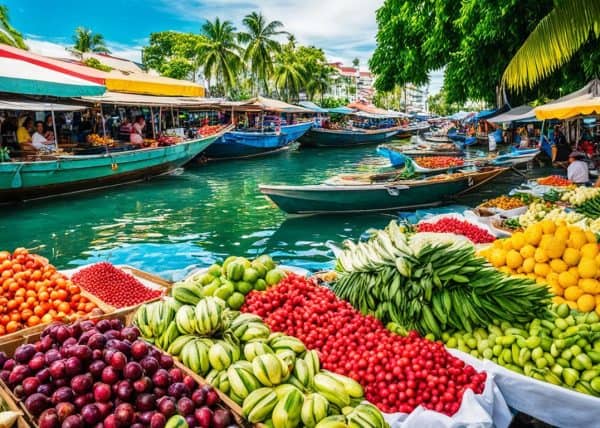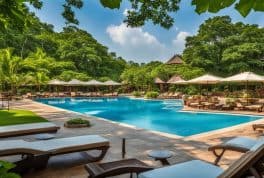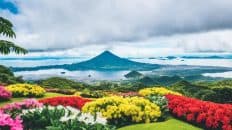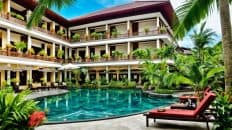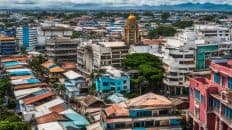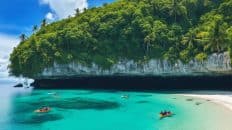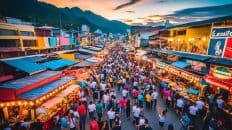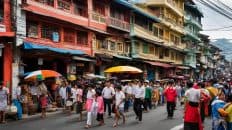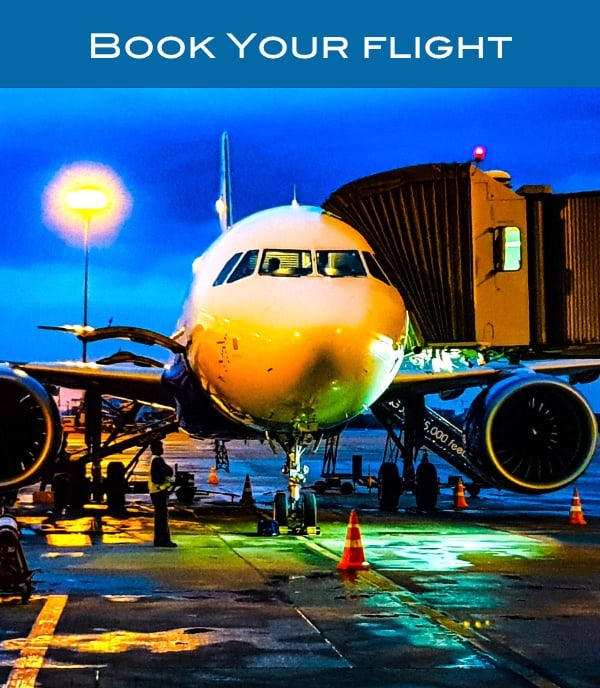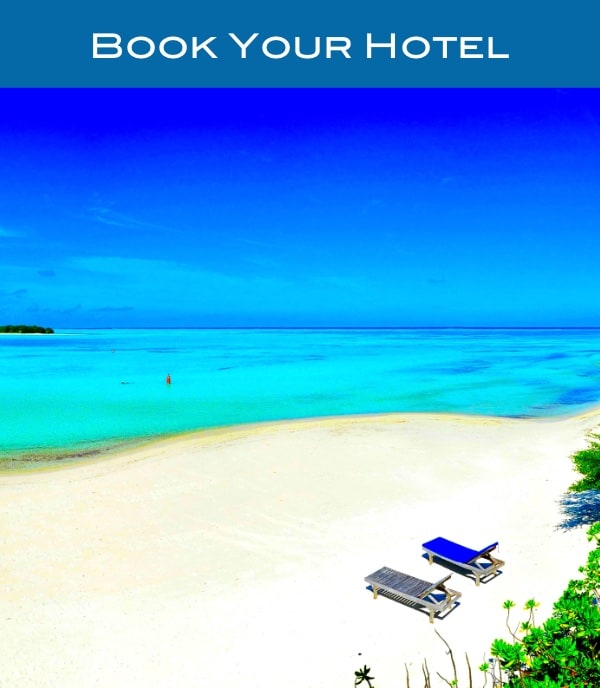Ultimate Philippines Tourist Guide
The Philippines is renowned for its stunning landscapes, rich culture, and warm hospitality. This Southeast Asian nation boasts beautiful beaches, historic sites, and unique natural wonders like the Chocolate Hills. Its diverse attractions, vibrant festivals, and delicious cuisine make it a compelling destination for travelers.
To explore Individual Islands, Regions, Cities, and Tourist Spots, look in the "Travel" Tab in the Main Menu at the top of this page.
@toddofthejungle TravelTips...
Table of Contents
Top 10 Questions and Answers for a Philippines Tourist
- What is the best time to visit the Philippines?
- The best time is during the dry season from December to May, with cooler temperatures from December to February and hotter weather from March to May.
- Do I need a visa to enter the Philippines?
- This depends on your nationality. Many countries have visa-free access for stays up to 30 days, but it's best to check with the Philippine embassy or consulate in your country.
- What are some must-visit destinations?
- Popular destinations include Boracay for beaches, Palawan for natural beauty, Manila for urban experiences, and Cebu for historical sites and diving.
- Is it safe to travel in the Philippines?
- Generally, yes, but it's advisable to stay aware of your surroundings, especially in crowded areas. Avoid travel to the far south due to ongoing security issues.
- What is the currency and should I exchange money before arriving?
- The currency is the Philippine Peso (PHP). It's usually better to exchange some money upon arrival for better rates, though ATMs are widely available.
- What language is spoken in the Philippines?
- Filipino (Tagalog) is the national language, but English is widely spoken, especially in tourist areas.
- What is the food like in the Philippines?
- Filipino cuisine is diverse and flavorful, known for dishes like adobo, sinigang, and lechon. Street food is also a must-try.
- How do I get around the islands?
- Domestic flights are the quickest way to travel between islands. Ferries are also available but slower. Within cities, taxis, tricycles, and jeepneys are common.
- What should I pack for a trip to the Philippines?
- Light, breathable clothing, sunscreen, a hat, swimwear, and comfortable footwear are recommended. Also, pack a raincoat or umbrella if visiting during the rainy season.
- Can I use my cell phone in the Philippines?
- Yes, but you may need to buy a local SIM card for better rates. Most urban and tourist areas have good cellular and internet coverage.

Traveling as a Philippines Tourist: A Guide for First-Time Visitors
Embarking on a journey to the Philippines, an archipelago brimming with vibrant culture, stunning landscapes, and friendly locals, is an experience that promises adventure and discovery. For first-time travelers, the prospect of exploring this Southeast Asian gem can be both exhilarating and daunting. This comprehensive guide aims to ease your journey, covering everything from finding airline tickets to choosing accommodations and booking exciting tour packages.
1. Finding the Perfect Flight
The first step in your travel plans is booking your flight. The Philippines is accessible from major international airports worldwide, with Manila's Ninoy Aquino International Airport (NAIA) being the primary gateway. When searching for flights, consider the following tips:
- Early Booking: Airfare tends to be more affordable when booked several months in advance. Keep an eye out for promotions and deals from airlines like Philippine Airlines, Cebu Pacific, and AirAsia.
- Flight Comparison Tools: Use flight comparison websites like Skyscanner or Google Flights to compare prices across different airlines. These tools can also alert you to price drops.
- Flexible Dates: If possible, be flexible with your travel dates. Flying mid-week or during off-peak seasons can significantly reduce airfare costs.
- Connecting Flights: Sometimes, booking connecting flights through major Asian hubs like Singapore, Hong Kong, or Bangkok can be cheaper than direct flights.
2. Choosing Your Accommodations
The Philippines offers a wide range of accommodation options to suit every budget and preference, from luxury resorts to budget-friendly hostels. Key considerations include:
- Location: Choose a location based on your itinerary. If you're exploring cities like Manila or Cebu, consider staying in central areas for easier access to attractions. For beach destinations like Boracay or Palawan, resorts or beachfront hotels are ideal.
- Budget: Set a budget for your accommodation. Websites like Booking.com, Agoda, or Airbnb offer a variety of options at different price points.
- Reviews and Ratings: Read reviews from previous guests on platforms like TripAdvisor. This can provide valuable insights into the quality of the accommodation and the service provided.
- Amenities: Consider what amenities are important to you, such as Wi-Fi, air conditioning, or a swimming pool.
3. Exploring the Islands
With over 7,000 islands, the Philippines is a treasure trove of experiences. Here’s how you can plan your exploration:
- Define Your Interests: Are you into historical sites, beaches, or adventure activities? Identifying your interests will help tailor your itinerary.
- Local Transportation: Familiarize yourself with local transportation options. Jeepneys and tricycles are common for short distances, while ferries and domestic flights connect the islands.
- Island Hopping: Don't miss the opportunity to go island hopping. Popular destinations include El Nido, Coron, and the Caramoan Islands. These tours often include snorkeling, beach visits, and sometimes meals.
- Cultural Experiences: Engage in cultural experiences such as attending local festivals, trying Filipino cuisine, and interacting with locals.
4. Booking Tour Packages
Tour packages can simplify your travel experience, offering curated itineraries that showcase the best of the Philippines. Here’s how to choose the right tour package:
- Research: Look for reputable tour operators with good reviews. Websites like Viator and Klook offer a variety of tours with user reviews and ratings.
- Customization: Some tour operators offer customizable packages. If you have specific places or activities in mind, inquire about tailored tours.
- Group Size: Consider the size of the tour group. Smaller groups offer a more personalized experience.
- Inclusions: Check what is included in the package. Some tours include meals, entrance fees, and transportation.
5. Travel Tips for First-Timers
- Language: English is widely spoken, making communication relatively easy for tourists.
- Currency: The local currency is the Philippine Peso (PHP). It’s advisable to carry some cash, as smaller establishments may not accept credit cards.
- Safety: Exercise standard precautions. Keep your belongings secure and be aware of your surroundings.
- Connectivity: Purchase a local SIM card for mobile data. Wi-Fi is available in most hotels and cafes.
- Respect Local Customs: Respect the local culture and traditions. Dress appropriately when visiting religious sites.
- Environmentally Conscious: Be mindful of your environmental impact. Avoid single-use plastics and respect wildlife and natural habitats.
- Health Precautions: Stay hydrated, use sunscreen, and be cautious with street food. Check with your health provider regarding any recommended vaccinations.
6. Enjoying Filipino Cuisine
Filipino cuisine is a delightful blend of flavors influenced by Spanish, Chinese, and Malay culinary traditions. Must-try dishes include adobo, lechon, sinigang, and for the adventurous, balut. Also, don't miss out on the tropical fruits like mangoes, coconuts, and durian.
7. Making the Most of Your Trip
- Flexibility: Be flexible and open to changes in your plans. Sometimes, unexpected opportunities can lead to the most memorable experiences.
- Cultural Sensitivity: Show respect for the local culture and traditions. This includes being polite and understanding of different customs and practices.
- Local Interaction: Engage with locals. Filipinos are known for their hospitality and friendliness. Learning from them can enrich your travel experience.
- Sustainable Tourism: Practice responsible tourism. Support local businesses, respect wildlife, and be conscious of your environmental impact.
- Documentation: Keep digital and physical copies of important documents like passports, IDs, and travel insurance.
- Emergency Preparedness: Have a plan for emergencies. Know the contact details of your country’s embassy and keep a list of local emergency numbers.
- Enjoy and Relax: Most importantly, take time to enjoy and immerse yourself in the beauty and diversity of the Philippines.
Embarking on a journey to the Philippines is more than just a vacation; it's an adventure that promises rich cultural experiences, breathtaking natural beauty, and the warmth of its people. By planning wisely and embracing the local way of life, you're set to have an unforgettable experience in this unique corner of the world. Happy travels!
The Philippines is a hidden gem in the world of tourism. This country offers a unique blend of natural beauty, cultural richness, and adventure, attracting a wide range of tourists from around the globe. From the stunning beaches of Boracay to the historic streets of Vigan, the Philippines has something for everyone. This article will explore various aspects of tourism in the Philippines, highlighting different examples that cater to various interests.
1. Beach Lovers: Boracay and El Nido
Boracay, a small island in the central Philippines, is known for its white sandy beaches and vibrant nightlife. The island's most famous beach, White Beach, is backed by palm trees, bars, and restaurants. Tourists flock here for the crystal-clear waters and the opportunity to engage in water sports such as scuba diving, snorkeling, and kite surfing. The island's lively atmosphere makes it a perfect destination for those seeking both relaxation and entertainment.
El Nido, on Palawan island, offers a more serene experience. Known for its dramatic limestone cliffs and hidden lagoons, El Nido is a haven for nature lovers. The area's biodiversity is astonishing, with its coral reefs being home to a variety of marine life. Tourists can explore the numerous islands dotting the Bacuit Archipelago, each offering its unique landscape and tranquility. El Nido is ideal for those seeking a peaceful retreat amidst nature's wonders.

2. Cultural Enthusiasts: Vigan and Cebu City
Vigan, located on Luzon island, is a UNESCO World Heritage site and one of the few remaining Spanish colonial towns in Asia. The city's architecture reflects a unique blend of local Philippine, Asian, and European colonial influences. Calle Crisologo, the city's most famous street, offers a glimpse into the past with its cobblestone streets and well-preserved houses. Visitors can ride in horse-drawn carriages, savor local delicacies, and immerse themselves in the rich history of the Philippines.
Cebu City, often regarded as the birthplace of Christianity in the Far East, is another cultural hub. The Basilica Minore del Santo Niño, which houses a statue of the Child Jesus believed to be miraculous, is a major attraction. The city's annual Sinulog Festival, a vibrant and colorful celebration in honor of the Santo Niño, attracts both local and international tourists. Cebu City's rich history, combined with its urban development, makes it a fascinating destination for those interested in the Philippines' cultural evolution.
3. Adventure Seekers: Mount Pulag and Davao
Mount Pulag, the highest peak on Luzon Island, is a must-visit for adventure enthusiasts. Known for its “sea of clouds” and the stunning views of the Milky Way at dawn, the mountain attracts trekkers and nature photographers. The trek through the mossy forests and grasslands of Mount Pulag is both challenging and rewarding, offering panoramic views of the surrounding mountains and valleys.
Davao, located in Mindanao, offers a different kind of adventure. It is home to Mount Apo, the highest mountain in the Philippines, and the Philippine Eagle Center, which conserves the critically endangered Philippine eagle. Davao is also famous for its exotic fruit farms, particularly the durian farms. Adventure tourism in Davao is diverse, ranging from mountain climbing and exploring wildlife sanctuaries to discovering the unique flavors of local fruits.
4. Relaxation Seekers: Siargao and Batanes
Siargao, primarily known as a surfing destination, has much more to offer. The island's laid-back atmosphere is perfect for those looking to escape the hustle and bustle of city life. Apart from surfing, tourists can enjoy island hopping, lagoon swimming, and exploring the Magpupungko Rock Pools. Siargao's unspoiled natural beauty provides a tranquil environment for relaxation and reflection.
Batanes, the northernmost province in the Philippines, is known for its idyllic landscapes and traditional Ivatan houses. The slow pace of life, combined with the stunning views of rolling hills, rugged cliffs, and the vast ocean, makes Batanes a perfect retreat for those seeking peace and solitude. The province's cultural heritage, reflected in its well-preserved customs and traditions, adds to the charm of this tranquil destination.
5. Food Lovers: Pampanga and Iloilo
Pampanga, known as the culinary capital of the Philippines, is a paradise for food lovers. The region is famous for its unique and flavorful dishes, such as sisig, a sizzling dish made from pig's head and liver, and kare-kare, a savory stew of oxtail and vegetables. Pampanga's culinary scene is a delightful exploration of traditional Filipino flavors and cooking techniques.
Iloilo, on the other hand, offers a different culinary experience with its famous La Paz Batchoy, a noodle soup made with pork organs, chicken, shrimp, and beef, served in a savory broth. The city is also known for its fresh seafood and native delicacies like piaya, a sweet flatbread. Iloilo's rich culinary heritage is a testament to the diverse influences that have shaped Filipino cuisine.
Conclusion
The Philippines, with its stunning landscapes, rich cultural heritage, and diverse culinary experiences, offers a comprehensive tourism experience. Whether one seeks relaxation, adventure, cultural immersion, or culinary delights, this Southeast Asian nation has something to offer. The tourism industry in the Philippines not only showcases the country's natural and cultural wealth but also plays a crucial role in its economic development. As more people discover the unique charms of the Philippines, it continues to emerge as a top destination on the global tourism map.
8. Introduction: Embarking on a Journey to the Philippines - A Paradise for Every Tourist
The Philippines, an archipelagic country in Southeast Asia, is a destination that captivates the heart of every tourist with its stunning natural beauty, rich history, and warm, welcoming people. With over 7,000 islands, it offers a diverse array of experiences, from pristine beaches and lush landscapes to vibrant cities and historical landmarks. This introduction serves as a guide for the Philippines tourist, providing insights into the various facets of traveling in this enchanting country.
Geographical Splendor and Diversity
The Philippines is blessed with a geographical diversity that is rare and awe-inspiring. Its islands are dotted with a range of landscapes – from mountainous terrains and volcanic landscapes to dense rainforests and expansive rice terraces. The country's extensive coastline boasts some of the world’s most beautiful beaches, with crystal-clear waters and rich marine life, making it a haven for beach lovers and diving enthusiasts alike. For the Philippines tourist, this means a plethora of choices – whether it's surfing in Siargao, exploring the Chocolate Hills in Bohol, or marveling at the Banaue Rice Terraces.
A Melting Pot of Cultures
The cultural fabric of the Philippines is just as diverse as its landscapes, shaped by its complex history of colonization, trade, and indigenous traditions. Influences from Spain, America, and Asia are evident in its cultural practices, festivities, and even in its cuisine. Each region in the Philippines offers a unique cultural experience, from the Spanish-influenced cities in Luzon to the indigenous tribes in Mindanao. For a Philippines tourist, this translates to a rich tapestry of cultural experiences – every island, every city, and every village tells a different story.
The Importance of Tourism
Tourism plays a significant role in the Philippines' economy and development. It not only contributes to economic growth but also fosters cultural exchange and understanding. As the country continues to welcome tourists from around the world, efforts have been made to develop sustainable tourism practices that protect its natural resources and benefit local communities. For the Philippines tourist, this means the opportunity to explore this beautiful country responsibly and sustainably, contributing positively to the preservation of its natural and cultural heritage.
A Destination for Every Traveler
Whether you’re an adventure seeker, a history enthusiast, a beach lover, or someone looking to immerse in a new culture, the Philippines offers something for every type of traveler. Its cities buzz with the energy of modern life, offering shopping, dining, and entertainment options. In contrast, its rural areas provide a peaceful retreat into nature and tradition. As a Philippines tourist, you are assured of an experience that is both enriching and memorable.

9. Preparing for Your Philippines Adventure: Essential Tips for Every Tourist
For a Philippines tourist, the journey begins long before setting foot on its pristine beaches or exploring its vibrant cities. Effective preparation is key to ensuring a smooth and enjoyable experience in this diverse and enchanting country. This guide aims to provide comprehensive advice on travel documentation, the best times to visit, and packing essentials for your trip to the Philippines.
Travel Documentation and Requirements
Passport and Visa Information:
As a Philippines tourist, your primary concern should be ensuring your travel documents are in order. A valid passport is a must, with at least six months' validity from your planned date of return. Visa requirements vary depending on your nationality. Many countries are eligible for visa-free entry for stays up to 30 days, but it's essential to check the latest regulations specific to your country. For longer stays, securing a visa from a Philippine embassy or consulate before your trip is necessary.
Customs and Entry Regulations:
Familiarizing yourself with the Philippines' customs regulations is crucial to avoid any issues upon arrival. Tourists are allowed to bring personal effects, a reasonable amount of tobacco and alcohol, and up to 10,000 PHP in local currency. Prohibited items include certain drugs, firearms, and some agricultural products. It's advisable to declare any electronic items or high-value goods to customs officials upon entry to avoid complications.
Health and Travel Insurance:
While not mandatory, having travel insurance is highly recommended for every Philippines tourist. This ensures coverage for unexpected medical emergencies, trip cancellations, or lost baggage. Additionally, check if your policy covers adventure activities if you plan to engage in such during your stay.
Best Time to Visit
Understanding the Climate:
The Philippines has a tropical maritime climate, generally hot and humid year-round. However, it experiences two main seasons – the rainy season (June to November) and the dry season (December to May). The best time to visit largely depends on your preferences and the regions you plan to explore.
Dry Season – Peak Tourist Period:
The dry season, especially between December and February, is considered the ideal time for most tourists. The weather is cooler and more manageable, making it perfect for beach activities and sightseeing. However, being the peak tourist season, expect higher prices and more crowded destinations.
Rainy Season – A Different Experience:
Traveling during the rainy season offers a unique experience. The landscapes are lush and green, and tourist spots are less crowded. However, be prepared for sporadic heavy rains and potential typhoons, especially from July to September. This season can be ideal for surfers, particularly in regions like Siargao, where the waves are at their best.
Packing Essentials
Clothing and Footwear:
Packing for the Philippines means preparing for warm weather. Light, breathable clothing made of cotton or linen is ideal. Include swimwear, a broad-brimmed hat, and UV-protection sunglasses for beach days. Comfortable walking shoes are essential for city tours and hiking. If visiting cooler areas like Baguio, pack a light jacket or sweater. Despite the season, always carry a raincoat or umbrella.
Gadgets and Medications:
In the digital age, keeping gadgets handy is necessary. A good quality camera or smartphone for photos, a power bank for charging on the go, and a universal travel adapter are essential. The Philippines uses 220V power and American-style flat two or three-pronged plugs. For those with specific medical needs, bring a sufficient supply of prescription medications, as well as a basic first-aid kit.
10. Discovering the Philippines: A Tourist's Guide to Unforgettable Destinations and Attractions
For the Philippines tourist, the archipelago offers a mosaic of experiences, each island telling its own story through natural beauty, historical landmarks, and cultural festivities. From the northern highlands of Luzon to the sun-kissed beaches of Visayas and the unexplored depths of Mindanao, every destination has something unique to offer.
Luzon: The Northern Jewel
Manila: Where History Meets Modernity
The bustling capital, Manila, is a mix of the old and the new. Intramuros, the walled city from the Spanish colonial era, stands as a testament to the Philippines' rich history. Here, a Philippines tourist can explore historical landmarks like Fort Santiago and Manila Cathedral. Beyond its historical charm, Manila offers modern attractions such as the vast SM Mall of Asia, vibrant nightlife, and a diverse culinary scene.
Banaue Rice Terraces: A Cultural Wonder
Traveling north from Manila leads to the magnificent Banaue Rice Terraces in the Ifugao province. These terraces, carved into mountainsides over 2,000 years ago, are not just agricultural marvels but also a symbol of the Philippines' cultural heritage. Hiking through these terraces offers breathtaking views and insights into the Ifugao community's way of life, a must-do for any Philippines tourist interested in cultural immersion.
Visayas: The Heart of the Archipelago
Boracay: A Beach Lover's Paradise
The small yet stunning island of Boracay in the Visayas region is famed for its white, powdery beaches, crystal-clear waters, and vibrant nightlife. White Beach is perfect for sunbathing, swimming, and various water sports, making it a favorite among tourists. Beyond the beach, explore the island's culinary delights and lively bars for a complete Boracay experience.
Cebu: A Mixture of History and Natural Beauty
Cebu, often referred to as the "Queen City of the South," is a treasure trove of historical sites and natural wonders. Historical landmarks like Magellan's Cross and the Basilica Minore del Santo Niño offer glimpses into the Philippines' colonial past. For nature lovers, a trip to the Kawasan Falls or whale shark watching in Oslob is unmissable.
Mindanao: The Land of Promise
Davao: Diversity and Adventure
Davao, the largest city in Mindanao, is known for its multicultural vibe and natural attractions. Mount Apo, the highest peak in the Philippines, offers challenging treks and stunning vistas. The Philippine Eagle Center is a haven for wildlife enthusiasts. Davao's mix of urban comforts and natural splendor makes it an intriguing destination for any Philippines tourist.
Siargao: Beyond Surfing
Siargao, rapidly gaining popularity, is not just a surfer’s paradise. Its allure lies in its unspoiled beauty, with hidden lagoons, secluded beaches, and unique rock formations. For the adventurous Philippines tourist, Siargao presents opportunities for island hopping, snorkeling, and exploring less-traveled paths.
11. Cultural Immersion in the Philippines: A Feast for the Senses
For the Philippines tourist, a trip to this archipelago is not just a journey through its islands, but also a deep dive into a culture rich in history, traditions, and flavors. The Philippines' cultural tapestry is woven with influences from its indigenous roots, Spanish colonial past, and modern global interactions, creating a unique and vibrant experience for every visitor.
Local Cuisine: A Melting Pot of Flavors
Exploring Filipino Cuisine:
Philippine cuisine is as diverse as its islands, offering a blend of flavors that reflect its varied cultural influences. Staples like rice, fresh seafood, and tropical fruits are the basis of many dishes. For a Philippines tourist, no culinary exploration is complete without trying Adobo, a savory meat dish cooked in vinegar, soy sauce, and garlic, or Sinigang, a sour soup that epitomizes Filipino comfort food.
Street Food Adventure:
To truly immerse yourself in Filipino culture, delve into the world of street food. It's here that you'll find the heart of Filipino culinary creativity. Balut, a fertilized duck egg, may challenge the more adventurous. For those with a less adventurous palate, options like Banana Cue (caramelized banana skewers) or Turon (a sweet banana spring roll) are delightful treats.
Dining Experiences:
The Philippines offers a variety of dining experiences. In urban areas, one can find high-end restaurants serving fusion cuisine, while rural areas offer a more traditional fare. A visit to a local 'Carinderia' or a roadside eatery will give a Philippines tourist a taste of home-cooked Filipino meals. Seafood lovers should not miss the Dampa seafood markets, where you can choose fresh seafood and have it cooked to your liking.
Festivals and Events: A Kaleidoscope of Culture
Vibrant Festivals:
The Philippines is a country that loves to celebrate, with festivals, known locally as 'fiestas,' occurring throughout the year. Each festival is a vibrant display of the country's culture, history, and traditions. For instance, the Sinulog Festival in Cebu is a colorful, lively celebration in honor of the Santo Niño, or the Ati-Atihan Festival in Aklan, which is known for its indigenous dance and music.
Participating in Local Celebrations:
As a Philippines tourist, participating in these festivals offers an unparalleled cultural experience. Engage with locals, learn the traditional dances, and savor the festive dishes. These celebrations are not only a window into the Filipino soul but also a testament to the country's rich history and diverse cultural influences.
12. Essential Travel Tips for the Philippines Tourist: Ensuring a Smooth Journey
Traveling to the Philippines, with its myriad of islands and diverse cultures, can be a thrilling adventure. However, for the Philippines tourist, understanding the nuances of local practices, health precautions, and financial matters is crucial for a hassle-free experience. This guide delves into the practical aspects of traveling in the Philippines, offering essential advice to navigate this beautiful country effectively.
Staying Connected: Communication in the Philippines
Mobile and Internet Connectivity:
In today's connected world, staying in touch is a priority for most tourists. The Philippines offers reliable mobile and internet services, especially in urban areas. Upon arrival, a Philippines tourist should consider purchasing a local SIM card, available at airports and stores, from providers like Globe and Smart. These SIM cards offer affordable data plans, ensuring connectivity throughout your trip.
Internet Access and Wi-Fi:
While major cities and tourist spots in the Philippines have good internet access, remote areas may be challenging. Most hotels and cafes offer Wi-Fi, but for uninterrupted access, especially if traveling to off-the-beaten-path destinations, a portable Wi-Fi device or a local SIM card with a data plan is advisable.
Health and Safety: Staying Safe and Healthy
Vaccinations and Health Precautions:
Health should be a top priority for any Philippines tourist. While there are no mandatory vaccinations for entry into the Philippines, standard vaccines such as Hepatitis A and Typhoid are recommended. The country has a tropical climate, making it prone to diseases like dengue, so carrying mosquito repellent and wearing protective clothing is wise.
Safety and Emergency Contacts:
The Philippines is generally a safe destination for tourists. However, like any travel destination, maintaining awareness of your surroundings and taking standard safety precautions is important. Valuables should be secured, and travel in unfamiliar areas should be done cautiously. It's also crucial to have a list of emergency contacts, including local emergency services and your country's embassy or consulate.
Budget and Expenses: Managing Finances
Cost of Living and Spending:
Understanding the cost of living is vital for budgeting your trip. The Philippines can be quite affordable, with options for every budget range. Accommodation, food, and transport costs vary, with urban areas generally being more expensive than rural ones. Street food, local eateries, and public transportation offer authentic experiences at a lower cost.
Money Management:
Credit cards are accepted in cities and tourist areas, but having cash is essential, especially in remote regions. ATMs are widely available, but it's advisable to carry enough local currency (Philippine Peso) for small purchases. Be mindful of exchange rates and transaction fees when using credit cards or withdrawing cash.

13. Sustainable and Responsible Tourism in the Philippines: A Guide for the Conscious Traveler
The Philippines, with its enchanting natural landscapes and rich cultural heritage, is a destination that beckons travelers from around the world. For the Philippines tourist, traveling responsibly is not just about enjoying the country’s offerings; it’s about preserving its beauty and contributing positively to its communities.
Environmental Awareness: Protecting the Philippines' Natural Wonders
1. Respecting and Conserving Natural Sites:
The Philippines is home to an array of unique ecosystems, from lush rainforests to vibrant coral reefs. A responsible Philippines tourist should be mindful of their environmental impact. This includes following guidelines in protected areas, avoiding activities that damage the environment, and being conscious of waste disposal.
2. Supporting Eco-Friendly Initiatives:
Many regions in the Philippines offer eco-tourism experiences, which focus on sustainability and environmental education. As a traveler, choosing accommodations and tour operators that practice sustainable tourism helps in conserving the environment. Look for establishments with certifications or policies on energy conservation, water use, and waste management.
Supporting Local Communities: Ethical and Cultural Considerations
3. Engaging with Local Businesses and Artisans:
One of the most enriching aspects of travel is engaging with local communities. As a Philippines tourist, shopping at local markets, dining at local eateries, and participating in community-run tours not only provide a more authentic experience but also help in distributing tourism benefits to local economies.
4. Cultural Sensitivity and Interaction:
Understanding and respecting local customs and traditions is crucial. This includes dressing appropriately, especially in rural or religious areas, and seeking consent before taking photographs of people or sacred sites. Learning a few basic phrases in the local language can also enhance interactions and show respect for the local culture.
Responsible Wildlife Experiences
5. Ethical Wildlife Encounters:
The Philippines offers diverse wildlife experiences, from whale shark watching to birding. However, it’s important to engage in wildlife tourism responsibly. This means choosing activities that do not harm or stress animals, avoiding direct interaction with wild animals, and supporting conservation-focused organizations.
Contributing to Community Development
6. Participating in Voluntourism and Community Projects:
For those seeking a deeper connection, participating in community development projects can be a rewarding experience. This could range from environmental conservation efforts to teaching and cultural exchange programs. It's essential to ensure that these activities are respectful, beneficial to the community, and sustainable in the long term.
14. Introduction: Embarking on a Journey to the Philippines - A Paradise for Every Tourist
The Philippines, an archipelagic country in Southeast Asia, is a destination that captivates the heart of every tourist with its stunning natural beauty, rich history, and warm, welcoming people. With over 7,000 islands, it offers a diverse array of experiences, from pristine beaches and lush landscapes to vibrant cities and historical landmarks. This introduction serves as a guide for the Philippines tourist, providing insights into the various facets of traveling in this enchanting country.
Geographical Splendor and Diversity
The Philippines is blessed with a geographical diversity that is rare and awe-inspiring. Its islands are dotted with a range of landscapes – from mountainous terrains and volcanic landscapes to dense rainforests and expansive rice terraces. The country's extensive coastline boasts some of the world’s most beautiful beaches, with crystal-clear waters and rich marine life, making it a haven for beach lovers and diving enthusiasts alike. For the Philippines tourist, this means a plethora of choices – whether it's surfing in Siargao, exploring the Chocolate Hills in Bohol, or marveling at the Banaue Rice Terraces.
A Melting Pot of Cultures
The cultural fabric of the Philippines is just as diverse as its landscapes, shaped by its complex history of colonization, trade, and indigenous traditions. Influences from Spain, America, and Asia are evident in its cultural practices, festivities, and even in its cuisine. Each region in the Philippines offers a unique cultural experience, from the Spanish-influenced cities in Luzon to the indigenous tribes in Mindanao. For a Philippines tourist, this translates to a rich tapestry of cultural experiences – every island, every city, and every village tells a different story.
The Importance of Tourism
Tourism plays a significant role in the Philippines' economy and development. It not only contributes to economic growth but also fosters cultural exchange and understanding. As the country continues to welcome tourists from around the world, efforts have been made to develop sustainable tourism practices that protect its natural resources and benefit local communities. For the Philippines tourist, this means the opportunity to explore this beautiful country responsibly and sustainably, contributing positively to the preservation of its natural and cultural heritage.
A Destination for Every Traveler
Whether you’re an adventure seeker, a history enthusiast, a beach lover, or someone looking to immerse in a new culture, the Philippines offers something for every type of traveler. Its cities buzz with the energy of modern life, offering shopping, dining, and entertainment options. In contrast, its rural areas provide a peaceful retreat into nature and tradition. As a Philippines tourist, you are assured of an experience that is both enriching and memorable.
15. Finding Love in the Philippines: A Tourist's Tale of Romance and Connection
For many a Philippines tourist, a journey to this archipelago isn't just about exploring its natural beauty or immersing in its rich culture; sometimes, it's about discovering love and forming deep, lasting connections. The Philippines, with its warm people and romantic landscapes, provides a perfect backdrop for stories of love and companionship.
The Magic of Filipino Hospitality
The Warmth of the Filipino People:
The Philippines is renowned for its people's hospitality and friendliness. For a Philippines tourist, this warmth often paves the way for deeper connections. Whether it’s through shared meals, cultural exchanges, or simply everyday interactions, tourists often find themselves forming bonds that go beyond the usual travel acquaintance.
Cultural Celebrations and Social Gatherings:
The country’s numerous festivals and social events are not just cultural spectacles; they are also gatherings that bring people together. For a tourist, participating in these events can lead to unexpected encounters and the blossoming of new relationships.
Romantic Escapes and Scenic Beauty
Idyllic Settings for Romance:
The Philippines boasts some of the world's most romantic and picturesque spots. Sunset views in Boracay, the serene beauty of Palawan’s lagoons, and the charm of the historic streets of Vigan create perfect settings for romance. For many tourists, these places become the backdrop of their love stories.
Adventures and Shared Experiences:
Adventures and shared experiences can often lead to strong bonds. Philippines tourists engaging in activities like diving, hiking, or exploring the islands often find themselves connecting with fellow adventure-seekers, leading to friendships and sometimes, romantic relationships.
Love in the Digital Age
Online Connections Leading to In-Person Meetings:
In today’s digital world, many relationships begin online. For some Philippines tourists, their journey starts with connecting with someone from the Philippines through dating apps or social media, leading to in-person meetings and the opportunity to explore the country together.
Long-Distance Relationships and Cultural Exchange:
Relationships formed in the Philippines sometimes turn into long-distance connections, offering opportunities for cultural exchange and learning. These relationships can provide a deeper understanding of Filipino culture and a strong personal connection to the country.
Challenges and Rewards
Navigating Cultural Differences:
Relationships between a Philippines tourist and a local can come with challenges, especially when navigating cultural differences. However, these relationships can also be incredibly rewarding, offering a unique blend of perspectives and experiences.
Stories of Successful Relationships:
Many tourists have found lasting love in the Philippines, leading to successful long-term relationships, marriages, and even new lives in the country. These stories often inspire other travelers in their quest for love and connection.
16. From Tourist to Expat: Embracing Life in the Philippines
For many a Philippines tourist, what starts as a short visit evolves into a lifelong journey, leading them to embrace the Philippines as their new home. The decision to transition from a tourist to an expat in the Philippines is often driven by the country's captivating charm, welcoming culture, and the promise of a relaxed lifestyle.
The Allure of the Philippines
1. Natural Beauty and Relaxed Pace of Life:
Many tourists are drawn to the Philippines' stunning natural landscapes and the relaxed pace of life. The country offers a variety of settings, from bustling cities to tranquil beach towns, catering to different preferences for an expat lifestyle.
2. Warmth and Hospitality of the Filipino Community:
The welcoming nature of Filipinos is often a key factor in a tourist’s decision to stay. The sense of community and belonging, coupled with the Filipinos' cheerful disposition, makes the transition to expat life smoother and more appealing.
Practical Considerations for Settling Down
3. Navigating Legalities and Residency:
Transitioning from a Philippines tourist to an expat involves navigating the legalities of residency. This includes understanding visa options, such as retirement visas, investment visas, or work visas, and complying with local laws and regulations.
4. Cost of Living and Real Estate:
The Philippines is known for its relatively low cost of living, which is attractive to expats. Real estate options vary widely, from affordable apartments in the city to beachfront properties, offering choices for various budgets and lifestyles.
Building a New Life
5. Community and Social Connections:
Building a new life in the Philippines involves creating a network of social connections. Expats often find communities through local clubs, expat groups, or through shared interests like diving, hiking, or cultural activities.
6. Work and Business Opportunities:
Some expats choose to start businesses, capitalizing on the growing economy and the tourism industry. Others find opportunities in sectors like education, technology, or work remotely. Navigating the business landscape requires understanding local business practices and regulations.
Challenges and Rewards
7. Cultural Adaptation and Challenges:
Adapting to a new culture can be challenging for expats. Understanding Filipino customs, language barriers, and navigating day-to-day life are part of the adjustment process. However, these challenges often lead to personal growth and a deeper understanding of Filipino culture.
8. Stories of Expats:
Many expats in the Philippines share stories of a fulfilling life, enriched by new experiences, friendships, and a deeper appreciation of the country’s diverse culture. These stories can be both inspiring and informative for potential expats considering a similar journey.
17. Conclusion: Reflecting on the Journey of a Philippines Tourist
After exploring the diverse and enchanting landscapes of the Philippines, experiencing its vibrant culture, and engaging with its warm and welcoming people, a tourist is often left with a profound sense of appreciation and an array of unforgettable memories. The journey through the Philippines is more than just a travel experience; it's an exploration of a nation's soul, a deep dive into a rich cultural tapestry, and an adventure in some of the most breathtaking landscapes on earth.
The Unforgettable Experiences
For the Philippines tourist, every moment in this country is an opportunity to discover something new. From the awe-inspiring beauty of its natural wonders like the Chocolate Hills in Bohol or the pristine beaches of Palawan to the bustling streets of Manila brimming with history and life, the Philippines offers a plethora of experiences. The adventures had here, whether they be under the sea exploring coral reefs or atop mountains witnessing sunrise over terraces, are the kind that leaves lasting impressions.
The Warmth and Hospitality of the Filipino People
One of the most striking aspects of the Philippines is the hospitality of its people. Tourists are often greeted with open arms and warm smiles, making them feel at home. This hospitality, coupled with the Filipinos' joyful spirit and resilience, adds an invaluable dimension to the travel experience. The interactions with locals, the stories shared, and the friendships formed are treasures that a Philippines tourist carries home.
The Richness of Filipino Culture and Heritage
The cultural immersion a tourist experiences in the Philippines is unparalleled. Each festival, dance, and dish tells a story of the country’s rich history and diverse influences. For a tourist, participating in local festivities, tasting the unique flavors of Filipino cuisine, and learning about the country’s history is not just about enjoyment but also about gaining a deeper understanding of the Filipino way of life.
The Lessons Learned and the Impact Made
Traveling through the Philippines is also a journey of personal growth and learning. It teaches the importance of environmental conservation, the value of cultural sensitivity, and the impact of supporting local communities. As a Philippines tourist, the choices made during the trip - from the activities participated in to the products purchased - can have a lasting impact on both the traveler and the host community.
Carrying the Philippines in the Heart
As the journey comes to an end, a Philippines tourist leaves with more than just souvenirs and photographs. They carry with them stories to tell, experiences to share, and a piece of the Philippines in their heart. This journey shapes perspectives, enriches understanding, and often ignites a desire to explore even more of what this beautiful country has to offer.
